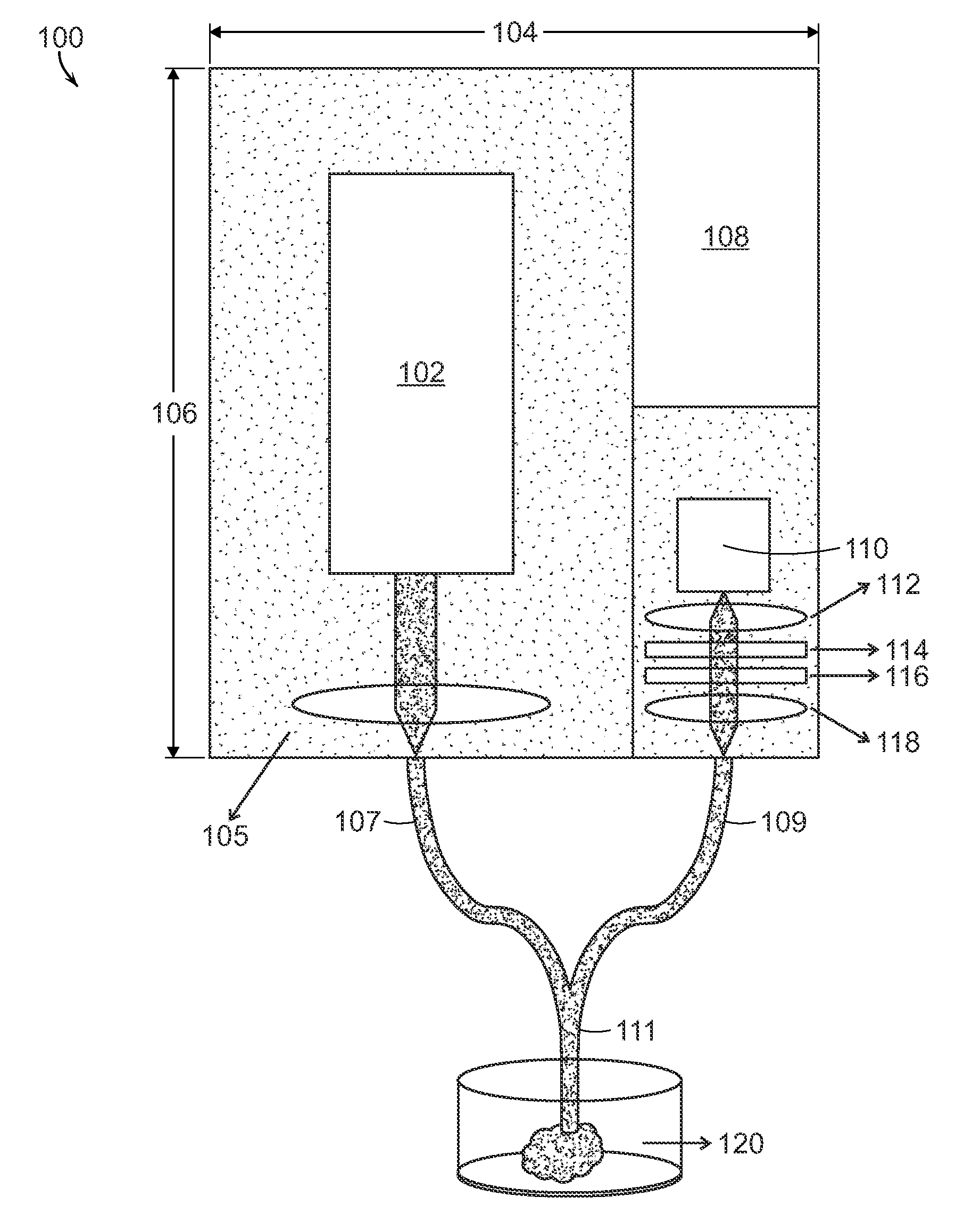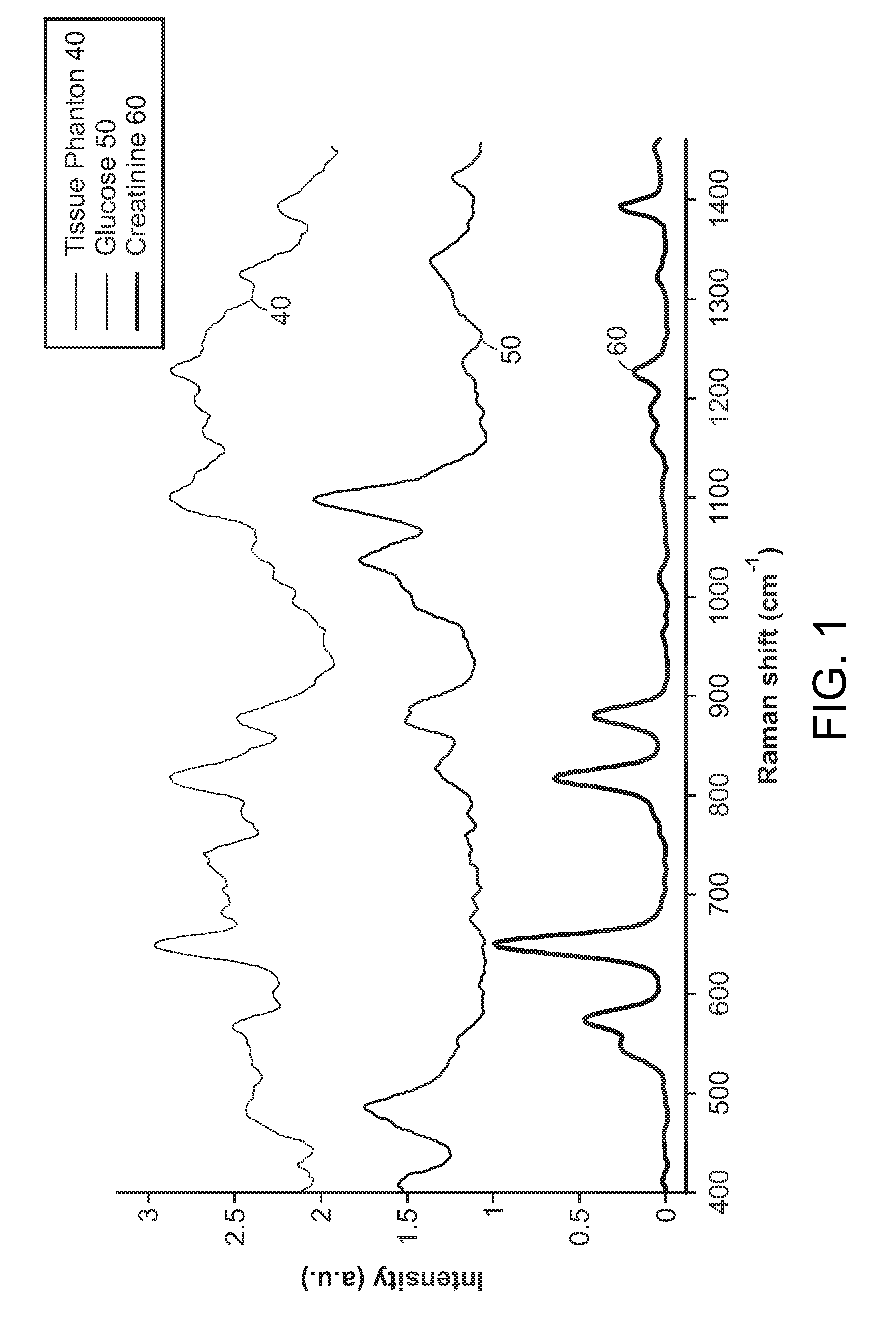[0005]The present invention relates to an
integrated approach utilizing a process of eliminating the uninformative or spurious spectral regions which simultaneously removes the necessity for a full
spectrograph-CCD
system. This approach enables the use of a portable Raman
diagnostic system, having significantly
reduced size and weight (less than 20 lbs and preferably less than 10 lbs) while retaining the required sensitivity.
[0008]An important consideration then is how many and which of the
spectral bands (also known as wavelength intervals) facilitate accurate prediction. In other words, as large portions of the full spectrum contains spurious information detrimental to the analysis, it is important to select the appropriate wavelength intervals. Addition of uninformative zones also gives rise to more loading vectors / principal components, which tend to incorporate irrelevant sources of variance and
noise thereby reducing the
efficacy of the system.
[0009]A preferred embodiment of the present invention uses wavelength interval selection based on non-
linear representation, such as support vector regression. The wavelength selection protocol is based on the minimization of cross-
validation error in the training data. This outperforms wavelength selection in typical
linear methods such as partial
least squares and
principal component regression. The
present method computes the
spectral window(s) or regions of the Raman spectrum where the effects of potential interference with respect to the
analyte of interest are minimized. This method also optimizes the selection of
spectral bands as opposed to selecting individual (and often isolated) spectral points (pixels). Any vibrational and rotational spectra give Voigt profiles that typically have a
full width at half maximum (FWHM) of at least 4-8 cm−l. The existence of such intrinsic spectral intervals leads to the selection of minimum spectral band size. The application of the preferred method leads to a significant reduction in number of wavelengths that need to be sampled (upward of three-fold as compared to full
spectrum analysis) for the development of an accurate calibration system. This reduction can be partly attributed to the chemical specificity of Raman
spectroscopy, which allows the detection of molecules by sampling a limited number of wavelengths. In addition, it has been found that the prediction accuracy and robustness are enhanced as a result of the wavelength selection procedure.
[0013]A preferred embodiment can include a plurality of excitation sources and a single
detector channel. The excitation can be performed by a sweeping source (e.g. polygon mirror
scanner sweeping source, Fabry-Perot tunable filter sweeping source, AOTF-based sweeping source) while the detection can be through a single bandpass filter and
photodetector. The sweeping source can cycle through a set of pre-assigned excitation frequencies to provide the different
wavenumber bands at the defined
wavelength range of the bandpass filter. The
advantage of using tunable excitation instead of tunable detection is that most of the tunable filters are
polarization sensitive and it is easier to ensure proper polarization of the
laser rather than correcting for the polarized
signal obtained after sample scattering. Depending on the application,
coupling multiple monochromatic sources such as
diode lasers onto the excitation
fiber can also provide another embodiment for implementing. It is essential to understand that incorporation of wavelength selection allows the
signal acquisition time to be shortened considerably because the instrument has to cycle through (serially) fewer number of spectral channels. Conversely, use of the same
signal acquisition time facilitates better signal-to-
noise ratio.
[0015]Finally, to accurately analyze a biological sample using a handheld unit, it is critical to collect a large number of backscattered (or transmitted) photons. A preferred embodiment utilizes a reflection geometry, however a transmission Raman system can also be used. To improve the collection efficiency, a compound
parabolic concentrator (CPC) lens can be used in conjunction with the
fiber-optic probe for delivery and collection of light to and from the sample, respectively. The CPC acts as a reverse angle
transformer by collecting light from all angles and converting them to the limited NA (
numerical aperture) of the collection fibers. The use of a CPC can enhance collection efficiency between 7-11 times in comparison to using only commercially available fibers. Alternately,
hollow core fibers and
photonic crystal fibers, which have significantly larger NA than conventional ones, can also be employed. The increase in collection efficiency provides for the application of a handheld instrument for
in vivo diagnostics as well as
ex vivo histo-
pathological analysis. A further embodiment utilizes a compound hyperbolic
concentrator that is matched with a lens for light collection from a
tissue sample.
 Login to View More
Login to View More  Login to View More
Login to View More 


